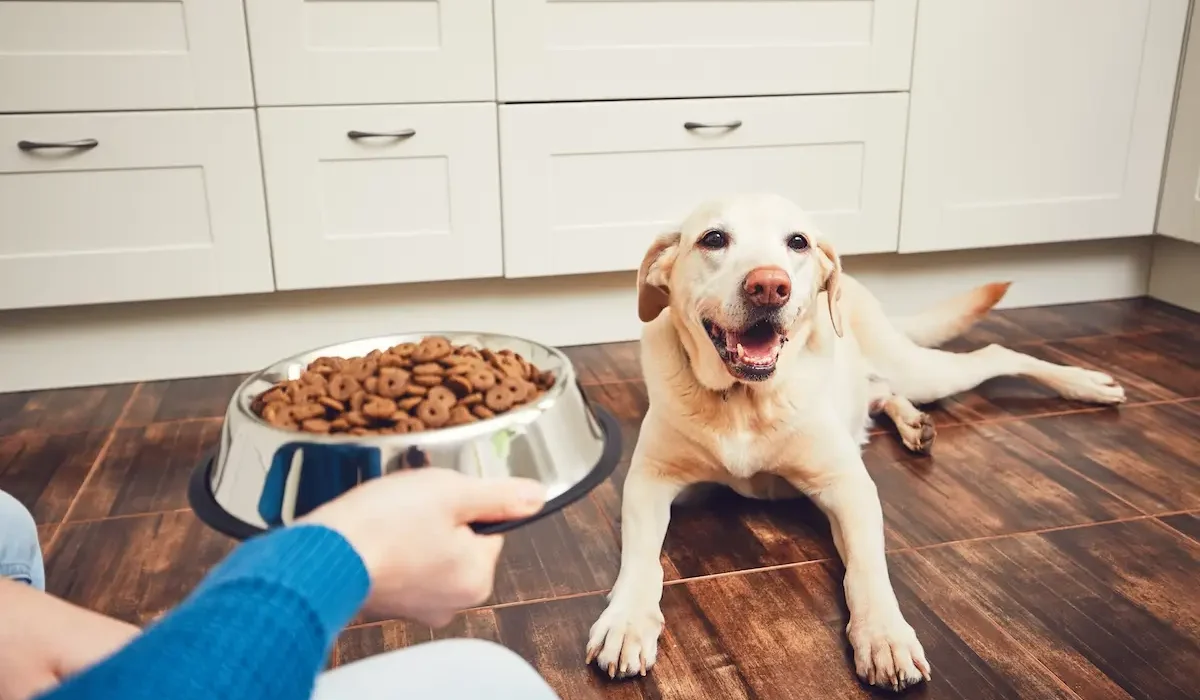If you own a dog, you may wonder how much dry food is appropriate for your pet. You’re not by yourself. It can be challenging to gauge how much food suits your dog, but it’s crucial for their general health and well-being. Discovering the ideal meal balance can significantly impact your dog’s growth, energy level, and ability to control their weight, regardless of breed or age. Now, let’s investigate dog nutrition and learn how to provide food for your four-legged friend.
Knowing What Your Dog Needs to Eat:
Before delving into how much dry Food is appropriate for your dog, it is crucial to comprehend their dietary requirements. A well-balanced diet rich in protein, carbs, fats, vitamins, and minerals is necessary for dogs. Specific requirements could change depending on size, activity level, age, breed, and activity level.
A dog’s diet must include protein since it aids tissue growth and repair, boosts the immune system, and gives the dog energy. Meat, fish, poultry, and lentils are good sources of protein. Grain and vegetable carbohydrates provide you with power and fibre. Fats are a concentrated energy source necessary for maintaining healthy skin and coat. Minerals and vitamins are essential for several body processes and general health.
Things to Take Into Account When Choosing How Much Dry Food to Give Your Dog:
Now that we know the fundamentals of your dog’s nutritional requirements let’s look at the variables that affect the amount of dry food you should give them. Some of these variables are age, weight, degree of exercise, and any underlying medical issues.
Age
Dogs need various foods at different phases of their lives. For example, puppies need extra calories and nutrients to promote their development and growth. Their needs may alter as they become adults. Senior dogs need fewer calories to avoid gaining weight and keep their general health intact.
Weight
The amount of dry food your dog should be fed is determined by their weight. In general, a dog’s calorie needs increase with weight. To avoid obesity or undernourishment, monitoring their weight and modifying their food intake is crucial.
Activity Level
Dogs who exercise frequently and are more active will need more calories than dogs who lead inactive lives. For example, working dogs can need more food to fuel their high-energy activities. Conversely, dogs who exercise less could need fewer calories to maintain weight.
Health Issues
Dietary adjustments may be necessary for some health issues like diabetes or allergies. Veterinarian-recommended customised diets may be beneficial for dogs with particular health issues. It’s crucial to speak with an expert to ensure your dog receives the nourishment he needs.
Dog Feeding Chart By Weight:
Indeed, here’s the dog feeding chart based on adult dog size and the corresponding amount of dry food per day:
| Adult Dog Size | Dry Food Per Day (cups) |
| Small (up to 20 lbs) | 1/2 to 1 1/2 |
| Medium (21 – 50 lbs) | 1 1/2 to 3 |
| Large (51 – 100 lbs) | 3 to 4 1/2 |
| Giant (over 100 lbs) | 4 1/2 to 6 |
How to Determine Your Dog’s Daily Calorie Consumption?
You might begin by calculating how many calories your dog consumes daily to calculate how much dry food to give them. A dog’s calorie requirements vary according to size, age, and activity.
You can use your dog’s optimum weight to approximate their calorie requirements. You can use your dog’s current weight if they are already at their desired weight. Multiply their poundage weight by the following formula:
- To maintain weight, multiply each pound of body weight by 15–20 calories.
- To lose weight, multiply each pound of body weight by 10–15 calories.
- Multiply by 20–25 calories per pound of body weight if you want to gain weight.
To maintain your dog’s weight, for instance, you would multiply 40 by 15-20 calories per pound, or 600–800 calories per day, if your dog weighs 40 pounds.
Remember that this figure is only a starting point and that the Food your dog receives will depend on their specific demands and physical condition.
Using the Dog Food Manufacturer’s Feeding Guidelines:
The majority of Dog food brands that are sold commercially have feeding recommendations on their packaging. These recommendations can be a helpful place to start because they are usually based on dogs’ everyday needs. But it’s crucial to remember that there are more than one-size-fits-all solutions with these recommendations.
It’s also critical to remember that certain dogs can have nutritional needs or intolerances. To choose the ideal diet for your dog, speak with your veterinarian if they have any allergies or sensitivities.
Keeping an eye on your Dog’s weight and Physical state:
To ensure your dog gets the proper amount of dry food, it’s essential to check their weight and overall health regularly. Gaining or losing weight may indicate that the diet needs to be changed.
You can use a scale or schedule routine weigh-ins with your veterinarian to monitor your dog’s weight. By watching their weight over time, you can see any patterns or changes that might call for dietary adjustments.
Typical Mistakes to Avoid When Giving Your Dog Dry Food:
To protect your dog’s health and well-being, you should avoid a few frequent blunders while giving them dry food.
Overindulgence in food
In dogs, overfeeding can result in obesity and weight increase. Following the suggested feeding guidelines and modifying the amount according to your dog’s particular requirements and physical state is crucial.
Feeding Variations
Since dogs thrive on consistency, setting up a regular feeding plan is critical. Feeding them regularly throughout the day can help control their digestion and stop hunger-associated behaviours.
Not Thinking About Treats
Treats are crucial to dog training and creating a stronger attachment. The calories from treats must be taken into account, though, when calculating how much dry food to serve. Moderate treat consumption should be factored into your dog’s total caloric intake.
Not supplying clean Water
Your dog’s health and digestive system depend on access to fresh water. Always ensure clean water is available, especially when people are eating.
You can make sure your dog is eating the proper amount of dry food and staying at a healthy weight by avoiding these typical errors.
Conclusion:
Proper dry food is crucial for your dog’s general health and well-being. You may decide how much food is right for your pet by considering their age, weight, activity level, and any underlying medical issues. Constantly monitor your dog’s weight and physical condition, and change their nutrition as necessary. Speaking with your veterinarian will help you make decisions and give you essential information about the unique nutritional requirements of your dog.
Read More: Discover the Glamour of the French Riviera





